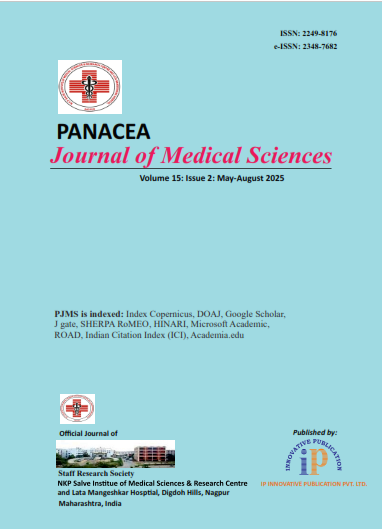Panacea Journal of Medical Sciences
Panacea Journal of Medical Sciences (PJMS) open access, peer-reviewed triannually journal publishing since 2011 and is published under auspices of the “NKP Salve Institute of Medical Sciences and Research Centre”. With the aim of faster and better dissemination of knowledge, we will be publishing the article ‘Ahead of Print’ immediately on acceptance. In addition, the journal would allow free access (Open Access) to its contents, which is likely to attract more readers and citations to articles published in PJMS.Manuscripts must be prepared in accordance with “Uniform requiremen...

A study to explore the perception of cadaveric oath taking ceremony in medical students of West Bengal
Page: 409-413
Background: “Cadaver is our first teacher” is most probably the first line that every medical student hears when they enter the dissection hall for the very first time. Every medical practitioner is indebted to these great souls who donated their body posthumously and to their families. From the year 2016 cadaveric oath taking ceremony was started in our country. In this ceremony 1st year MBBS students take a pledge or oath before touching the cadaver in anatomy dissection hall. The oath marks a formal commitment that underscores the importance of respect and professionalism while working with cadaver.
Aims and Objective: This study was conducted to assess the impact of that cadaveric oath taking ceremony among students.
Materials and Methods: The study was conducted in the department of anatomy in Murshidabad Medical College, Murshidabad, West Bengal. After taking Institutional ethical clearance a Google questionnaire was formed and validated. 125 students were requested to go through that questionnaire before and after the cadaveric oath taking ceremony. Students’ responses were recorded and analyzed.
Result: It has been noticed that, where before cadaveric oath taking 2.4% students were thinking that the ceremony might not be necessary, after oath taking 100% students responded it was necessary. In this study students’ responses were linked to the five-point Likert Scale, a type of psychometric response scale in which responders specify their level of agreement to a statement typically in five points: (1) Strongly disagree, (2) Disagree, (3) Neither agree nor disagree, (4) Agree and (5) Strongly agree. In every question the percentage of students who strongly agreed before ceremony was increased after taking oath. Hence it can be declared that this cadaveric oath taking must influence the students’ mind.
Conclusion: The objectives of the study was checked with the result and a positive influence was observed correlating with the cadaveric oath taking ceremony.
Article Metrics
- Visibility 18 Views
- Downloads 6 Views
- DOI 10.18231/pjms.v.15.i.2.409-413
-
CrossMark
- Citation
- Received Date June 08, 2024
- Accepted Date March 12, 2025
- Publication Date August 19, 2025